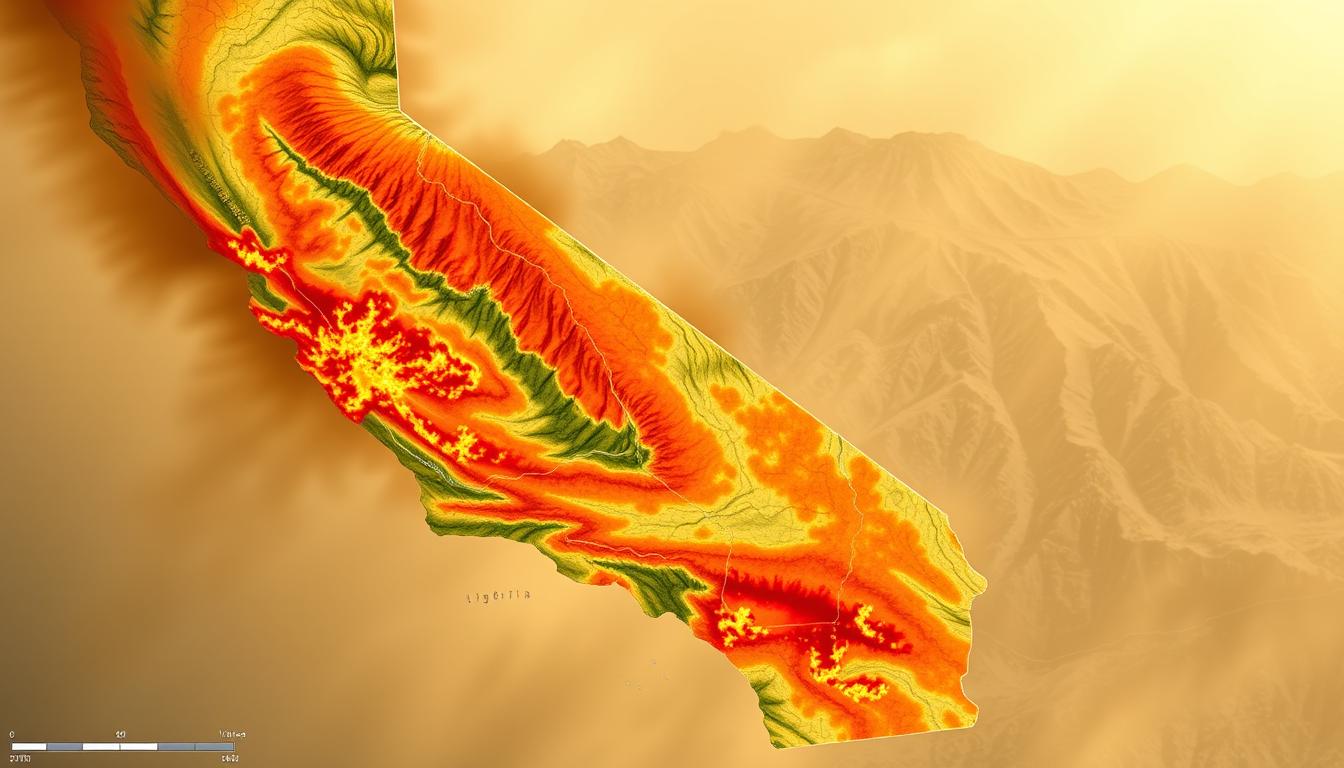Wildfires are common in California, especially in spring, summer, and early fall. The california fires map is a key tool for staying safe. It shows where fires are, how big they are, and how well they’re being fought. This helps you make better choices for your family.
Right now, many big wildfires are burning across the state. The Palisades Fire has grown to over 17,200 acres, affecting 23,000 people. The Eaton Fire has sadly taken five lives and burned 10,600 acres. The Hurst Fire is only 10 percent contained, having burned 855 acres.
Other fires, like the Sunset Fire and Woodley Fire, are smaller but still a concern. Wind gusts of 60 to 80 mph are making these fires spread fast. It’s important to stay updated with the california fires map and alerts from apps like Frontline Wildfire Defense.
Key Takeaways
- The california fires map is an essential tool for tracking active wildfires.
- Real-time updates help users stay informed about the current wildfires in California.
- Fires such as the Palisades Fire and Eaton Fire highlight the need for vigilance.
- Wind conditions can significantly impact fire spread, making real-time information crucial.
- Apps like Frontline Wildfire Defense offer tailored alerts for enhanced safety.
Understanding the California Fires Map
The California Fires Map is a key tool for everyone in the state. It shows where wildfires are happening in real-time. This helps people know if they are in danger and if their homes are safe.
What is the California Fires Map?
This map shows where fires are in California and how big they are. It uses icons to mark fires, making it easy to see where they are. By using the map, people can see if they might be in danger and get ready.
How to Read the Map Legend
Knowing the map legend is important. It explains what each symbol means. Symbols show fire perimeters and hotspots, where fires are most active. This helps people understand the map better.
Key Features of the Map
The california fires map has many useful features:
- Real-time incident updates: You get news about fires as they happen.
- Search functionality: You can find out about fires near you by searching.
- Evacuation alerts: The map shows where you might need to leave your home.
Updated Fire Information Sources
Getting timely and accurate wildfire updates is key. Knowing where to find this info helps people make smart choices during emergencies. Official and unofficial sources give real-time fire info, keeping communities in the loop.
Official State Resources
CAL FIRE is a top source for wildfire updates in California. Their site has a detailed california fire map today. It shows active fires, containment progress, and resources. Updates are frequent, helping people understand fire situations.
Federal Agencies Involved
Federal groups like the U.S. Forest Service and FEMA are also crucial. They offer important data and help in disaster relief. Working with state officials, they ensure accurate updates and a unified effort against fires.
Local News Outlets
Local news is vital during wildfires, providing quick reports on fire status and evacuations. Their coverage keeps communities updated on fire dangers and safety steps. Following local news helps residents stay informed and ready for emergencies.
Real-Time Fire Alerts and Notifications
Staying informed during wildfires is key for safety and protecting property. Real-time alerts help people act fast when fires are near. Using apps and systems for fire alerts is a big plus in knowing about threats.
These alerts include updates on nearby fires, air quality, wind changes, and evacuation orders. As wildfires hit many places, it’s vital for people to know how to get these alerts.
Importance of Staying Informed
Timely info can save lives during wildfires. With conditions changing fast, updates help keep communities safe. Groups like Watch Duty send over 7 million people wildfire updates in 2024.
Getting accurate and timely alerts is crucial. This can be through texts or apps.
How to Sign Up for Alerts
Signing up for fire alerts is easy to get real-time updates. People can register with local agencies for wildfire info and safety tips. You just need to give your contact info on their website or app.
Many systems send alerts on air quality and evacuations. Staying in touch with these agencies helps you prepare for fires.
Mobile Apps for Fire Updates
Many apps offer quick wildfire info. The Frontline Wildfire Defense App is one, giving users detailed updates and alerts. It tracks firefighting planes and uses cameras for better awareness.
| Alert System | Features | Sign-Up Method |
|---|---|---|
| Watch Duty | Real-time wildfire updates, evacuation orders | Via website or mobile app |
| ALERTCalifornia | High-definition fire surveillance, air quality monitoring | On California agency websites |
| Frontline Wildfire Defense | Monitoring firefighting aircraft, emergency alerts | Mobile application download |
Current Major Fires in California
The wildfires in California are causing a lot of trouble and danger. It’s important to know which areas are hit the hardest. This helps both residents and emergency teams. A wildfire tracker gives real-time updates, keeping everyone informed and safe.
Overview of Active Fire Zones
Right now, several big fires are causing a lot of concern:
- Five people have died because of these fires.
- Over 179,000 people in Los Angeles County must leave their homes.
- More than 200,000 are warned to get ready to leave.
- Almost 2,000 buildings, like homes and shops, have been lost.
- It’s expected that over $8 billion in damages will be covered by insurance.
Regions Most Affected by Fires
The fires are hitting California hard, especially in these areas:
| Fire Name | Area Burned (Acres) | Status |
|---|---|---|
| Palisades Fire | 17,200+ | Active |
| Eaton Fire | 10,600 | Active |
| Hurst Fire | 855 | Limited Containment |
| Lidia Fire | 350 | 40% Contained |
| Sunset Fire | 43 | Shrinking |
Strong winds are making the fires worse, with winds over 60 mph. This is only the third big fire in January in the last 30 years. A wildfire tracker is key to staying safe during this crisis.
Historical Data from Previous Fires
California has a long history of wildfires. Looking at past fires teaches us important lessons. By studying previous years, we see how weather, plants, and climate affect fire risks.
Lessons Learned from the Past
In recent years, wildfires have changed. For example, in April 2023, there were 305 fires from the 2022 season. CAL FIRE handled most of these, with 176 fires. This shows the growing need for better fire management.
In October 2022, there were 372 wildfires from 2021 and 500 from 2020. Each year, the concern about wildfires grows.
Historical Fire Patterns in California
More wildfires have been reported in recent years. By 2025, CAL FIRE had already seen 13,926 incidents. This is a big jump from before.
Looking at the numbers, we see patterns:
- 2018: 413 wildfires
- 2019: 312 wildfires
- 2020: 500 wildfires
- 2021: 372 wildfires
- 2022: 305 wildfires
These numbers show the growing problem. In 2025, wildland fires burned 29,053 acres. By learning from the past, we can improve how we prevent and fight fires.
Preparing for Wildfires
In areas where wildfires are common, getting ready is key to staying safe. Having a good emergency plan helps families act fast and right when fires happen. It’s important to have rules for talking, leaving, and keeping essential items ready.
Creating a Family Emergency Plan
Creating a solid emergency plan takes a few steps:
- Choose a meeting spot outside your home for family members to meet if you get separated.
- Set up ways to stay in touch, like texting or using social media.
- Know the best ways to leave and make sure everyone knows how to get out.
- Give each family member a job, like getting certain items or taking care of pets.
Essential Supplies to Have Ready
Having the right stuff can make evacuating easier. Make sure your emergency kit has:
- Food that won’t spoil and can last for days
- Water for at least three days
- Medicines and first aid stuff
- Flashlights and extra batteries
- Important papers in a waterproof bag
- A way to charge your phone or a backup battery
Evacuation Routes to Consider
Planning ahead can save a lot of time when you have to leave fast. Look into different ways to leave your area, thinking about:
- More than one way to go, in case the main roads are blocked.
- How you’ll get around, like your car or public transport.
- Places to stay temporarily, like shelters.
Knowing and using these tips can help you feel more at ease during wildfire season. It’s a big part of getting ready for wildfires.
| Supply Item | Purpose |
|---|---|
| Non-perishable Food | Sustenance during evacuation |
| Water | Hydration needs |
| First Aid Kit | Address injuries |
| Flashlights | Provide light in power outages |
| Documents | Safeguard important information |
Impact on Air Quality and Health
Wildfires pose a big risk to air quality, affecting people near and far. In California, nearly 30,000 acres have burned. Over 17 million residents in the South Coast Air Basin are under advisories. It’s important to understand the impact.
Understanding AQI Levels
The Air Quality Index (AQI) shows air pollution levels and health risks. In places like Altadena, Downtown Los Angeles, and Malibu, air quality is unhealthy. High winds are making air quality worse in Los Angeles and nearby areas.
People, especially children and the elderly, need to be careful. They are more at risk from poor air quality.
Health Precautions During Fires
To reduce smoke exposure, using N95 masks is recommended. They block harmful particles. Staying inside when air is bad helps too.
Using air purifiers and keeping HVAC filters clean also helps. Avoid burning candles or doing things that make air worse. As fires continue, keeping air quality safe is key.
Community Resources and Support
Wildfires can really hurt communities, forcing families to leave and causing a lot of stress. It’s important to have community support and places to stay during these hard times. Many groups are working hard to help those affected by these disasters.
Local Shelters and Relief Efforts
Local shelters are key in giving safe places for people to go. In Southern California, big efforts are being made to set up shelters in fire-hit areas. For example, the Pasadena Convention Center is housing hundreds, especially the elderly from care homes.
Groups like Direct Relief are also helping by giving out important medical supplies. They’re sending out N95 masks and personal care items to those who need them.
How to Assist Those Affected
Help from the community can really help families get through tough times. Here are some ways to help:
- Volunteer at local shelters.
- Give donations or money to aid groups.
- Spread the word about help and services available.
- Work with local groups on relief efforts.
By coming together, we can really help in the recovery and support those struggling during this hard time.
Evacuation Zones and Safety Tips
Knowing about evacuation zones and following safety rules during wildfires is key. It keeps people and their families safe. Spotting these zones helps communities act fast in emergencies, cutting down risks and boosting safety.
Identifying Evacuation Zones
Evacuation zones are areas decided by fire behavior, land shape, and buildings. People need to know about these zones to stay safe. In the Los Angeles area, evacuation orders span from North Mulholland Road to Kenter Road and to the Pacific Coast Highway.
Local emergency offices quickly share updates on these zones. This ensures people get the latest info.
Safety Protocols During an Evacuation
It’s vital to follow safety steps during an evacuation. Before leaving, you can prepare your home. Here are some tips:
- Gather important documents and medications.
- Pack essential supplies, like food, water, and clothes.
- Make sure pets are ready and have a safe way to travel.
- Lock up windows, doors, and any entry points to your home.
- Listen to local authorities about road closures and where to go.
These steps protect your stuff and help emergency teams. Evacuating is a team effort to stay safe during dangers like wildfires.
Educational Resources about Fire Prevention
Getting the right fire prevention education is key to keeping communities safe from wildfires. Local efforts like workshops and community programs teach people how to lower fire risks. These programs help people take steps to protect themselves and their homes.
Workshops and Community Programs
Many community programs offer workshops on fire safety. At these workshops, you can learn:
- How to clear space around your home
- About local fire laws
- Yard care tips to avoid fires
- How to make an emergency kit
By joining these workshops, you not only learn about fire safety. You also meet your neighbors and work together to fight fires. It’s a smart move for anyone living in areas at risk of fires.
Online Resources and Guides
The internet has lots of resources and guides on fire prevention. Federal and state agencies share important info online, including:
- Maps showing fire risk areas
- Guides on keeping your home safe from fires
- News on local fire conditions
- Online courses on fire awareness
Using these online tools helps you stay informed and lower fire risks at home. Online learning adds to what you learn in community programs, making neighborhoods stronger.
| Resource Type | Description | Availability |
|---|---|---|
| Workshops | In-person learning sessions focusing on fire protection | Local community centers |
| Online Courses | Digital programs covering fire safety techniques | Web-based platforms |
| Guides | Informative documents on best practices for fire risk reduction | Government websites |
| Maps | Real-time mapping of fire risk zones and updates | Mobile apps and websites |
The Role of Technology in Fire Response
Technology has changed firefighting a lot. It helps in many ways, like watching from the air and mapping data. This tech helps manage wildfires better. It also makes sure resources are used right when needed.
Drones and Satellite Imagery
Drones have changed how we see wildfires. CAL FIRE uses them more now. They help with tasks like starting fires and checking on them fast.
With satellite pictures, firefighters can spot fires better. This helps them plan and send help faster. It’s very important in emergencies.
GIS and Mapping Technologies
Geographic Information Systems (GIS) are key in fighting fires. They help map out fires as they happen. This lets firefighters analyze data quickly.
Tools like FIRIS give updates on fires fast. AI helps find fires sooner. This shows how tech makes firefighting better.
| Technology Type | Function | Impact on Fire Response |
|---|---|---|
| Drones | Aerial assessments, ignition tasks | Faster data collection, improved situational awareness |
| Satellite Imagery | Fire detection | Enhanced monitoring capabilities |
| GIS | Mapping and data analysis | Improved resource allocation and real-time updates |
| AI Tools | Fire detection | Quicker alerts and operational insights |
Technology is making firefighting better in California. It helps save lives and property. With more tech and innovation, the future of fighting fires looks good.
Future Outlook for California Fire Management
California’s fire management is facing a big challenge as wildfires get more frequent and intense. In 2024, wildfires burned 127% of the 10-year average acres. This shows a worrying trend. Climate change is a big threat to the state’s health and environment.
Experts say California will need strong fire strategies soon. This is due to droughts and changing weather patterns.
Increasing Fire Frequency and Intensity
The wildfire season in California is now almost all year. This is because of severe droughts and more “fire days.” In December, extreme weather, like 75 mph winds, made fires worse. This highlights the need for new fire management methods.
La Niña might last until March, making fire prevention harder.
Strategies for Improvement and Innovation
Improving fire management is key. More money for fire protection, from $800 million in 2005-06 to $3.7 billion in 2021-22, helps. Better early warning systems and defensible spaces around homes are important.
Working together and using new technologies are crucial. This will help create effective fire strategies. These strategies aim to reduce damage and save lives in the face of growing threats.




